|

map of crosses
field
guide
irish prehistoric tombs:
court-tombs
portal-tombs
passage-tombs
wedge-tombs
stone
circles
petroglyphs
(rock art)
standing-stones
stone
forts, crannógs & souterrains
ogam-stones &
cross-pillars
cross-pillars
& cross-slabs
enigmas
of the irish crosses
part two
sweathouses
ireland
& the phallic continuum
satan
in the groin
the
earth-mother's
lamentation
east of brittany:
megaliths of western and southern france
génie
française
sitemap

Search
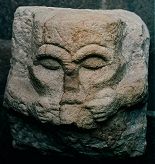
|

ENIGMAS
OF THE IRISH CROSSES
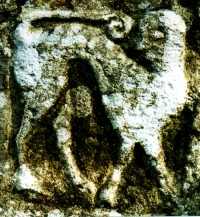
Rough
sgraffitoed slabs evolved in Ireland to high-relief slabs and
elegant cross-shaped pillars. Then in a remarkable evolution the
cross-shaped pillars acquired their typical rings, and became
large complex sculptures with ornamentation, figures and scenes
all over their surfaces: the so-called High Crosses. These forehadowed
a far greater evolution which occurred in Central, Western and
Southern France in the eleventh century - the Romanesque, the
greatest art movement the world has ever known.
Ireland,
a country on the fringe of Europe, had its own version of Christianity.
Ireland had no martyrs, and Irish monks, influenced by Syrian
and Coptic Christianity (abbots could marry, for example) lived
in autonomous monasteries answerable to no Metropolitan, Bishop
or Pope. Many monks lived in alone as hermits, or in very small
groups on remote headlands or islands. Most of the monasteries
were small and primitive, but some (on rich grazing land) became
large and rich. They attracted visitors from an unstable Continental
Europe - and probably some monks travelled to Western France and
Northern Spain, where they saw Merovingian and Roman sarcophagi,
and Vizigothic churches. The Latin cross with ring, thought to
be an Insular development or quirk, has Coptic and Byzantine models.
At
any rate, some sophisticated sculptors were attracted from the
Continent to Ireland and met craftsmen proficient in the whirls
and knots of Celto-AngloSaxon-Pictish ornament (fine examples
of which can be seen at Ahenny and Tibberaghny) which derived
from metal-and-wood artefacts. High-relief figure-sculpture was
something entirely lacking in Ireland - if we discount the very
phallic Turoe Stone - but it arrived at some time in the late
9th century.
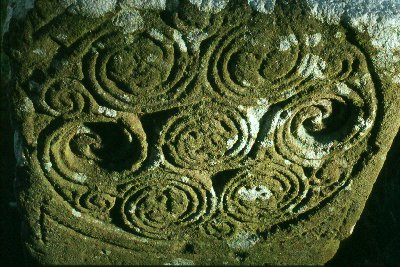
The richest
Irish monasteries - far poorer and simpler than the later cultural
engine of the Benedictine monasteries of Europe, and with only
remote access to the Classical sculpture and architecture, which,
though ruinous or damaged, littered France, Italy and Spain -
erected Teaching Crosses - the Scripture Crosses which
have seen so much damage, destruction, neglect and pollution-dissolution.
These are modest achievements compared with the great basilicas,
cathedrals and collegiates which mushroomed all over Europe from
the middle of the eleventh century - but they are appropriate
to an island which had been going its own quiet and modest way
while the rest of Europe to the East and South was dominated by
Imperial Rome - and the consequences of its collapse.
The Continental
origin and inspiration of the later Scripture Crosses is evidenced
by the rarity of any Irish element in their iconography: no Irish
saints (from whom there are so many to choose besides Patrick
- from the early Declan to the late Columbanus, Fiacre and Gall)
and no Irish legends or references. The snake, which features
on 'Muiredeach's Cross at Monasteroice', had never been part of
Irish iconography, but was a very common symbol of earthiness
and evil in Europe. In early mediæval iconography it had
positive significance, being associated with Terra, herself partly
modelled on Greek if not Minoan avatars.
The Irish
element is shown by the choice of certain subjects relating to
the monastic tradition: the saints Anthony and Paul the Hermit,
and subjects such as the life of King David which appealed to
the Celtic heroic tradition.
But the
first slabs and pillars are obviously influenced by (or shared
their origin with) contemporaneous carvings in Scottish Pictland
(Christianised by St Columba) and feature strange beasts and scenes
with horsemen.
Just as the Romanesque
churches of southern Europe carried enigmatic images of
strange beasts and bizarre scenes as well as hackneyed
but magnificent depictions of the Crucifixions, the Prophets,
Christ in Glory, the Resurrection and the Damned in Hell,
so the Irish crosses have their own enigmas.
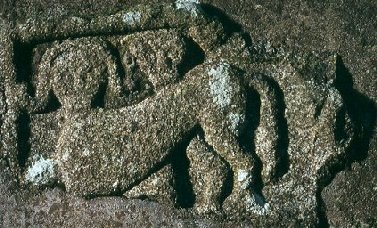
This Centaur is very Pictish in appearance.
|
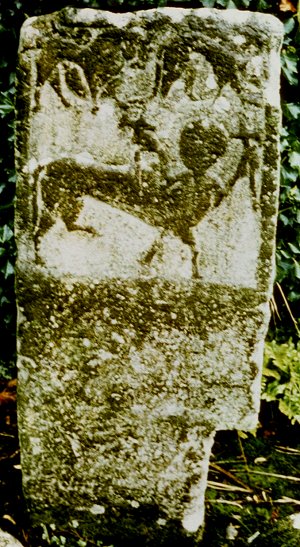 This carving resembles a famous Pictish
centaur
This carving resembles a famous Pictish
centaur
(with foliated branches) on a slab at Meigle (Perthshire). |
|
The
common scenes on Irish Scripture Crosses include the Fall
of Man, the first murder (Cain and Abel), the Sacrifice
of Isaac, the Children in the Fiery Furnace, David playing
his harp from the Old Testament. New Testament scenes include
the Flight into Egypt, the Massacre of the Innocents, the
Baptism of Jesus, the Miracles of the Loaves and Fishes
and the Wedding at Cana, the Crucifixion, Christ in Glory,
and so on. Daniel in the Lions' Den on the east side of
crosses prefigures the Crucifixion on the west side.
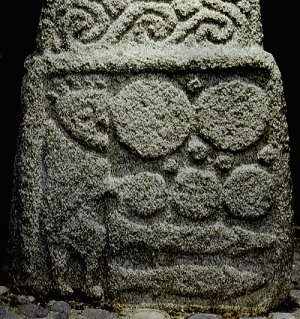
South Cross, Castledermot.
|

Muiredeach's Cross, Monasterboice.
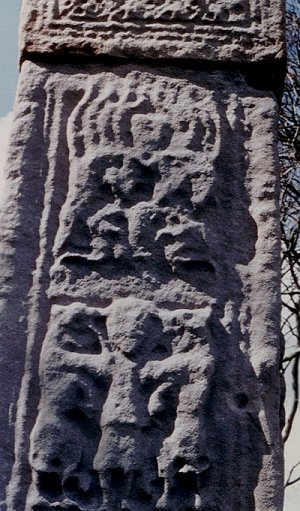
Arboe .
|
Daniel and the Lions on the Tower Cross at Kells.

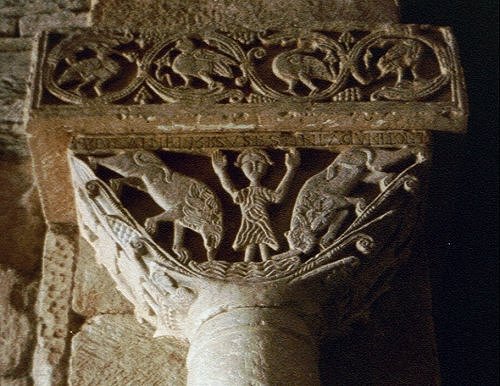
 Daniel and the Lions on a Vizigothic (8th century) capital at
San Pedro de la Nave (Zamora), Spain
Daniel and the Lions on a Vizigothic (8th century) capital at
San Pedro de la Nave (Zamora), Spain
and on a late-twelfth century capital in the church of Sainte-Radegonde
in Poitiers (Vienne), France. 
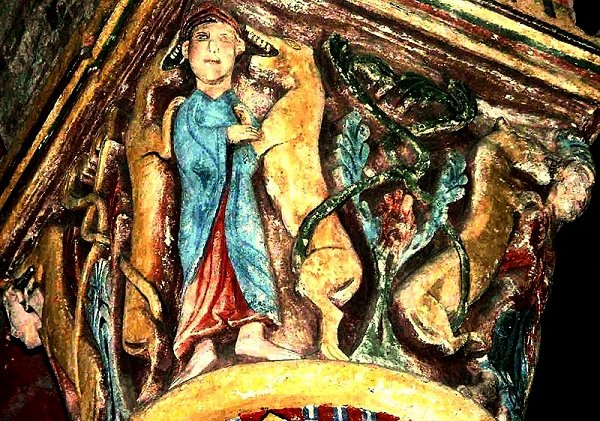
|
The Fall of Man
is the commonest Old Testament scene on Irish crosses.
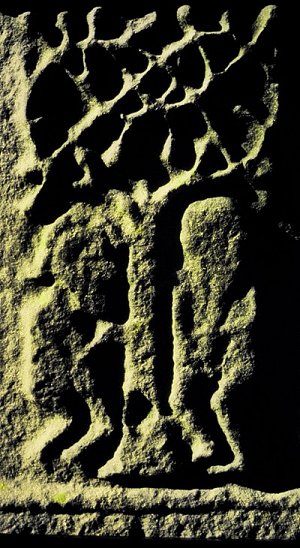
Lisnaskea: cross from Galloon Island.
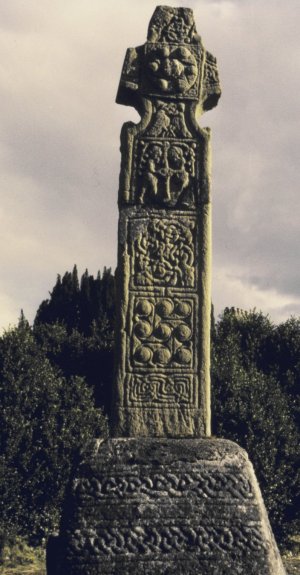
Kinnitty (Castletown and Glinsk).
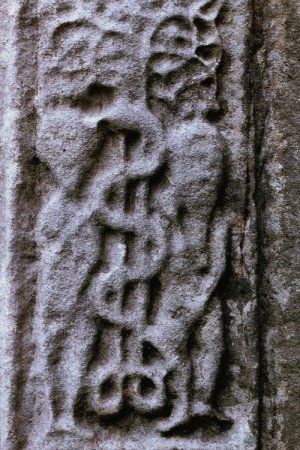 Boho.
Boho. |
On
the Moone cross Adam and Eve are at the top, with the Sacrifice
of Isaac and
the Ordeal of Daniel below. 
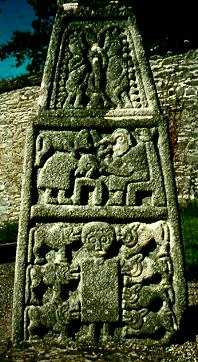
Compare the sacrifice
of Isaac here
with a very sophisticated capital of a little earlier
in Vizigothic Spain)
At Killary (below)
Adam and Eve are at the bottom, with Noah's Ark immediately
above, then the Sacrifice of Isaac and Daniel in the Lions'
Den. So the discrete sections of Irish crosses were to
be read either from the top down, or from the bottom up.

The
story of Noah is not common on Irish crosses. But at Castledermot
there is a fine representation of the animals being driven
along to the Ark.

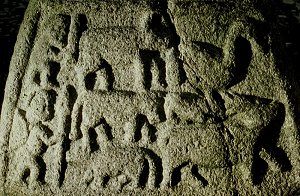
|
| Though Daniel and
the Lions and the Sacrifice of Isaac, for example, appear
on Vizigothic churches of the 9th century, Saints Anthony
and Paul in the Syrian Desert - the first Hermits or 'Desert
Fathers' - hardly occur at all in the European Romanesque,
but appear on several Irish crosses, along with strange scenes
such as Whispering Beasts which might be the Tempation of
Saint Anthony the Hermit - or might not.
On
the Moone Cross (right) with its famous depiction
of the 12 Apostles on its base below the Crucifixion, the
North side of the base shows the Raven brings SS Anthony
and Paul a loaf of bread at their desert rendezvous. The
second panel is the Pictish-looking "Whispering Beast"
motif which may be the Temptation of Saint Anthony. The
bottom panel may be the Beast of the Apocalypse - missing
one of its seven heads.
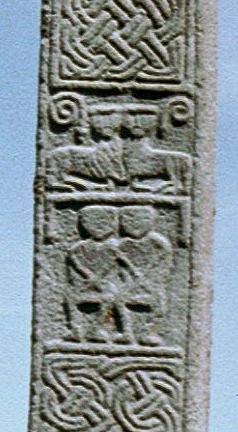
|

|
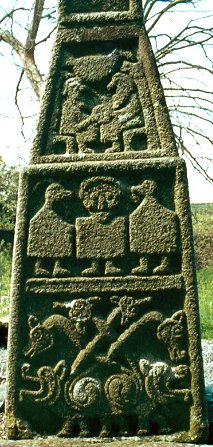
|
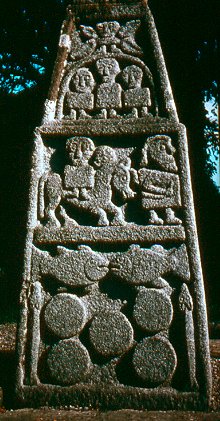 South side of base showing the
Miracle of the Loaves & Fishes; the Flight into
Egypt; the Children in the Fiery Furnace.
South side of base showing the
Miracle of the Loaves & Fishes; the Flight into
Egypt; the Children in the Fiery Furnace. |
 Saints Paul the Hermit and Anthony are shown on the Clonca
cross with hands on their laps. But what do the very Mesopotamian
(or Pictish!) lions or sphinxes mean ?
Saints Paul the Hermit and Anthony are shown on the Clonca
cross with hands on their laps. But what do the very Mesopotamian
(or Pictish!) lions or sphinxes mean ?
Note the wicker-like interlace carving.
|
|
The
human figure between two beasts is very common. These two
pictures show two different scenes on the Market Cross at
Kells. The scene on the right is placed below the ring on
the North side, while the scene below is on the West face.
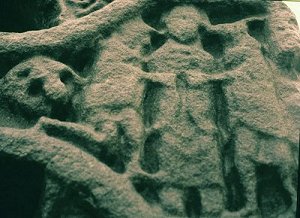
While
the scene above (resembling one on a Pictish stone at Kettins,
Angus) might be the Temptation of Saint Anthony (though
he is unbearded), that on the right is completely mysterious,
because the braid-bearded figure has a bovine tail, while
his right ear is ?bitten by one of the pawing or mauling
beasts.
The genital
area - which is the centre of the design - has been defaced.
It is not
clear whether the beasts, his beard or his hands - or all
three - were covering it.
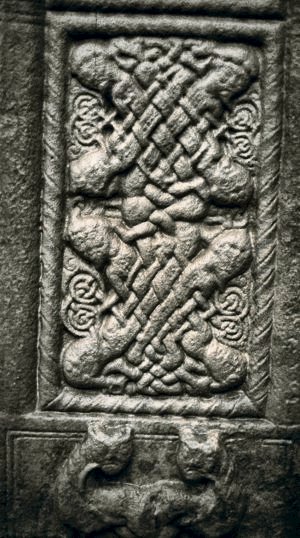
 Also on Muiredach's Cross at Monasterboice is a clever interlace
of beards (left) symbolising - what ? - the companionship
or the mortal danger lurking in the companionship of monks
?
Also on Muiredach's Cross at Monasterboice is a clever interlace
of beards (left) symbolising - what ? - the companionship
or the mortal danger lurking in the companionship of monks
?
And
what are the cat-like lions doing underneath this panel
?
Are they hellish beasts ?
part

two
|
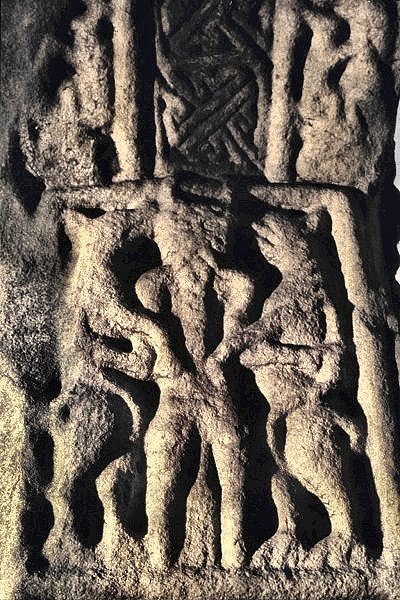
This
"whispering beasts" carving with Pictish overtones
is echoed, like many carvings on Irish crosses, by similar
- often earlier - metalwork figures, such as this one from
a portable cross from Tully Lough, county Kildare.
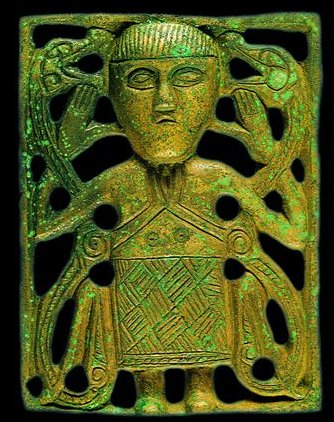
The
motif is also very Romanesque, and would not be out of place
on a twelfth-century doorway in Poitou or Gascony. Compare
it with the Poitiers capital of Daniel (above).
Click the picture above for interesting
solarisations of this panel.
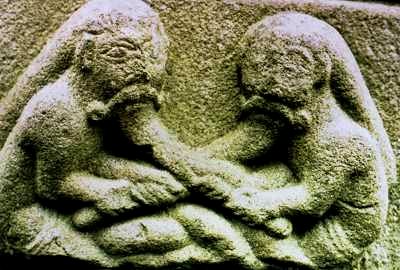
 The motif of mutual beardpullers also occurs on Continental
Romanesque churches, where it may represent the sin of mutual
masturbation: a common concern amongst celibate monks.
These beardpullers,
however, do not seem to be monks, since they have their
hair (and perhaps their beards) in a kind of bag worn by
the rich and known as a tresse.
The motif of mutual beardpullers also occurs on Continental
Romanesque churches, where it may represent the sin of mutual
masturbation: a common concern amongst celibate monks.
These beardpullers,
however, do not seem to be monks, since they have their
hair (and perhaps their beards) in a kind of bag worn by
the rich and known as a tresse.
Click the picture above for a Catalan
example.
|
NOTE:
like Romanesque churches (and Greek sculpture and prehistoric
rock-engravings) Irish crosses were originally polychrome-painted.
|
|
![]()


























